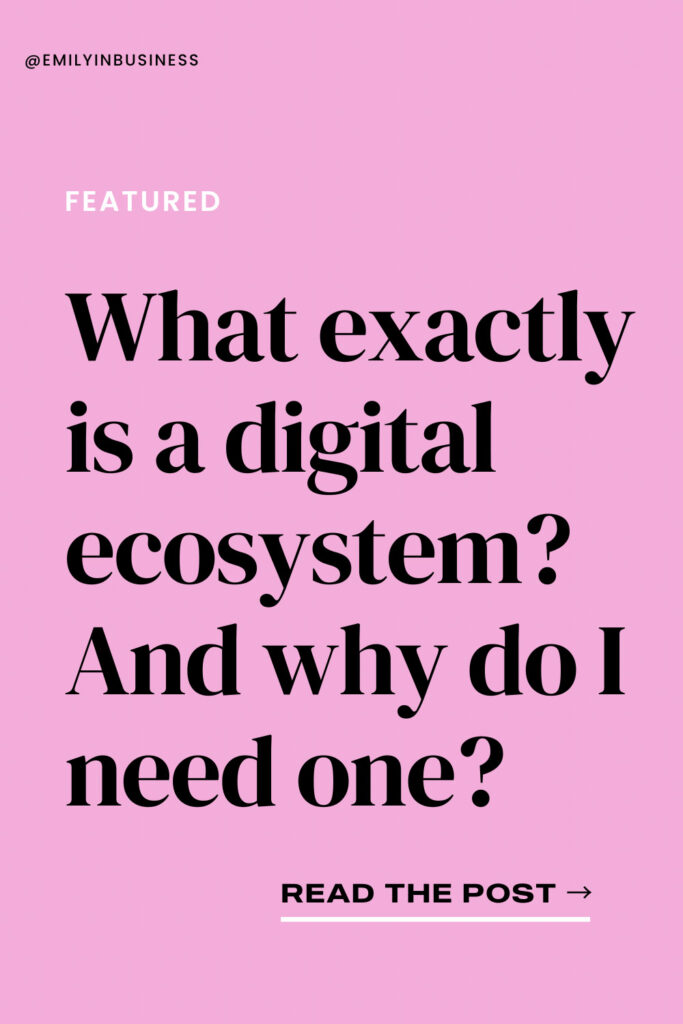What exactly is a digital ecosystem? And why do I need one?
Jan 10
This post may contain affiliate links, which means I’ll receive a commission if you purchase through my links, at no extra cost to you. Please read the full disclosure for more information.
In 2025, successful businesses don’t just use digital tools… they seamlessly weave them together to create powerful, automated workflows that drive growth. Before jumping into building your Digital Product Empire lets first understand the Digital Ecosystem landscape! As technology continues to evolve, understanding how to build and manage these connected systems has become essential for businesses of all sizes.
The days of disconnected software and manual data entry are behind us. Today’s digital ecosystems enable everything from automated customer journeys to real-time analytics, transforming how we run our businesses. Whether you’re a solopreneur or leading a growing team, the art of mastering these interconnected systems is key to staying competitive.
This guide will walk you through the fundamentals of digital ecosystems in 2025, showing you how to build connections between your tools that create real business value. We’ll explore the core technologies driving this transformation, practical strategies for implementation, and ways to avoid common pitfalls that can waste time and money.
By understanding how to harness the power of connected digital tools, you’ll be able to build a business that’s more efficient, scalable, and ready for whatever comes next. Let’s dive into what makes modern digital ecosystems work and how you can make them work for you.

Understanding Digital Ecosystems
Think of a digital ecosystem like a living, breathing city… it’s not just about individual buildings, but how they all connect and work together to serve its residents. Let me show you what I mean.
Defining the Digital Ecosystem
Have you ever noticed how your phone, laptop, and smart devices all seem to know what you need before you do? That’s a digital ecosystem in action. Today’s business systems work the same way. Your sales platform doesn’t just track sales… it talks to your marketing tools, updates your inventory, and even helps predict what customers will want next.
I learned this lesson when I tried running my business with separate tools for everything. It was like having a city where people had to walk between buildings instead of using roads and transit. Once I connected my core systems, and simplified…. everything started flowing naturally.
Key Technological Drivers
The tools powering these connections have come a long way. AI now handles tasks I used to spend hours on… like sorting customer requests or spotting sales trends. Cloud computing means I can access everything from anywhere, just like using Google Drive but for my whole business.
Ecosystem Architecture
Building a good digital ecosystem is like laying out a city plan. You need main streets (core systems), neighbourhoods (different departments), and ways for everything to connect. I start by mapping out how information needs to flow… an example of this is like making sure a new sale automatically triggers inventory updates, customer notifications, and shipping labels.
The key is making sure everything can grow with you. I learned this the hard way when my first system couldn’t handle holiday sales volume. Now I build in room to grow from the start.
Value Creation Mechanisms
The real power comes from how these connected systems create value. When your tools work together, each new customer or sale makes your whole system smarter. It’s like a snowball effect… your marketing learns from sales data, your customer service improves from feedback, and everything gets better over time.
For example, I connected my social media to my CRM, and suddenly I could see exactly which posts led to sales. This kind of insight helps you make better decisions and spot opportunities you might have missed.
Remember, you don’t need to build everything at once. Start with connecting the tools you use most, then grow from there. Focus on links that make your daily work easier and help you serve customers better. That’s how you build an ecosystem that works for you, not the other way around.
Strategic Implementation of Digital Ecosystems
Let me share what I’ve learned about putting digital ecosystems into action. If you were building a house… what would you need? a solid plan, the right tools, and a clear understanding of how everything fits together. Digital Ecosystems are the same.
Ecosystem Design Principles
Start with your foundation. I learned this the hard way when I rushed into connecting systems without a clear plan. Now I know better… you need to map out how everything will work together before you start building. Think about how your tools will share information, what standards they’ll follow, and how you’ll keep everything secure.
The trick is making sure your systems can talk to each other easily. It’s like making sure all your power outlets work with your appliances. I always check if new tools will play nice with my existing ones before buying. And don’t forget about rules and regulations… do some research because they’re like building codes for your digital ecosystem.
Technology Integration Approaches
The real magic happens in how systems connect. APIs are like digital handshakes. They let your tools share information safely. I shifted from clunky all-in-one platforms to smaller, specialised tools that connect through APIs. It’s more flexible and usually works better.
Cloud computing has changed everything. Instead of being stuck with one system, you can mix and match services to get exactly what you need.
Organisational Transformation
Getting your team on board is crucial. I’ve seen great systems fail because people weren’t ready to use them. Start with training and support. Help your team understand why these changes matter and how they make work easier.
Leadership needs to guide this change. When I implemented new systems, I made sure to show my team how they helped us work better together. It’s about building confidence and skills along with your technology.
Risk Management
Security isn’t just a checkbox… like updating legal pages, it’s an ongoing process. Think about protecting your digital ecosystem like protecting your home. You need good locks (cybersecurity), privacy (data protection), and backup plans for when things go wrong.
I always have backup systems ready, like having a spare key with a trusted neighbour. And I stay up to date with regulations… they’re always changing, and it’s easier to keep up than catch up.
Remember, implementing a digital ecosystem is a journey, not a race. Take it step by step, make sure each piece works before adding the next, and keep your team involved throughout the process. That’s how you build something that lasts and grows with your business.
Future Trends and Emerging Opportunities
Let me walk you through what’s coming next in digital ecosystems…. it’s both exciting and practical for your business. I’ve been watching these trends develop and testing new approaches with real clients.
Emerging Technology Convergence
AI is getting smarter and faster every day. I recently helped a small business use AI to predict their busy season, something that used to take weeks of analysis now happens automatically. Edge computing is bringing powerful processing closer to where we need it. Instead of sending data to far-away servers, businesses can now process information right where it’s created, making everything faster and more reliable.
The real game-changer is how these technologies work together. Think about how your phone’s weather app predicts rain minutes before it starts… now imagine that level of prediction for your business needs, inventory, and customer behaviour.
Industry-Specific Ecosystem Evolution
Every industry is finding its own way to use these connected systems. Healthcare providers are connecting patient care systems to make treatment faster and more accurate. Banks are using digital platforms to offer services that used to take days in just minutes.
I’ve watched manufacturing companies transform their supply chains with connected sensors and automated ordering. A client of mine cut their inventory costs by 30% just by connecting their systems to automatically order supplies when needed.
Sustainability and Social Impact
Green technology isn’t just good for the planet… it’s good for business. Companies are using digital ecosystems to track and reduce their environmental impact. I’ve seen businesses set up systems that monitor their energy use and automatically adjust to save power and money.
These systems are also making it easier to work together for social good. Businesses can now track their entire supply chain to ensure ethical practices and share this information transparently with customers.
Global Ecosystem Dynamics
Business borders are disappearing in the digital world. I work with clients who run global operations from their laptops, connecting with partners and customers worldwide. Digital platforms are making it possible for small businesses to operate internationally with the same tools big companies use.
The key is staying flexible and ready to adapt. Markets and technologies are changing fast, but if you build your digital ecosystem the right way, you can quickly adjust to new opportunities as they appear.
Remember, you don’t need to implement every new technology that comes along. Focus on the ones that solve real problems for your business. Start with what makes sense now, but build in a way that lets you add new capabilities as you grow. The future is exciting, but it’s most valuable when you can turn it into practical improvement.
Conclusion
The digital tools we use today are just the beginning. I’ve watched businesses transform from struggling with basic automation to running smoothly with connected systems that practically manage themselves. Your business can make this same journey.
Here’s what I know for sure: success in 2025 isn’t about having the most expensive tools or the fanciest technology. It’s about making smart choices about how your systems work together. Every business owner I’ve helped through this process started with the same question: “Where do I begin?”
Start with these simple steps:
- Look at your current tools – which ones do you use every day?
- Spot the manual tasks that eat up your time
- Map out where your systems could talk to each other better
- Pick one connection to build first… maybe linking your calendar to your client communication
The businesses that thrive tomorrow will be the ones that start connecting their digital dots today. You don’t need to do everything at once. Even small improvements in how your systems work together can make a big difference.
Remember that smoothie bowl comparison? Start with your essential ingredients… the tools you can’t live without. Get those working together smoothly first. Then you can add more toppings… new tools and connections as your business grows.
Ready to take the first step? Look at the tasks you’ll do tomorrow and ask yourself: “Could this work better if my systems were connected?” That’s how your digital ecosystem journey begins.
The future is digital, connected, and closer than you think. Let’s build it together, one smart connection at a time.
BEST OF THE MANUAL
Can I let you in on something that’s been driving me crazy? I’ve watched countless bloggers exhaust themselves in the create-publish-repeat cycle, churning out new content week after week, only to see their SEO results stay frustratingly flat. Meanwhile, the bloggers who figured out this one secret are quietly dominating search rankings with half the […]







+ Show / Hide Comments
Share to: